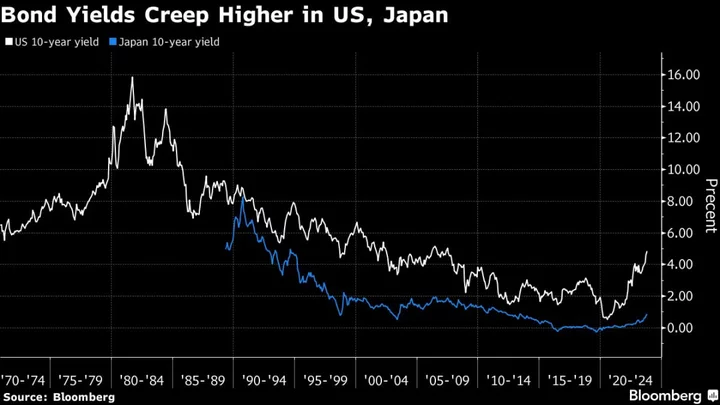It’s been a tempestuous year for US Treasuries. The coming week will set the stage for how it ends.
In the span of just a few days, investors will get updates on the major forces responsible for the unusually high volatility in the US bond market as it heads toward an unprecedented three-year loss. Saturday’s escalation of the Israel-Hamas conflict will also draw the attention of investors, though in recent weeks haven flows into Treasuries have been largely outweighed by concerns over the direction of monetary and fiscal policies.
The federal government will spell out how many new bonds it will sell to plug the budget deficit, which is testing the market’s capacity to absorb a seemingly endless supply of Treasuries. The Federal Reserve and the Bank of Japan will telegraph where monetary policy is heading, which may help shape demand from buyers overseas. And on Friday, the Labor Department will release its monthly employment report, a closely watched indicator of whether tighter monetary policy is cooling the economy as much as policymakers want.
It’s a crucial juncture for the bond market, where 10-year Treasury yields during the past week briefly surged above 5% for the first time since 2007 before pulling back down. Such moves have whipsawed investors, who are divided over whether yields will climb back up as the economy keeps going strong — or start sliding as high rates slow the economy.
“We’re going through a period of volatility,” said Amar Reganti, fixed-income strategist at Hartford Funds, who previously served as deputy director of the US Treasury’s debt-management department. “The data is uncertain, there’s uncertainty about the composition of Treasury supply, and then there’s a shift among the buyer base.”
Below are some of the highlights of the next week’s events:
Bank of Japan
The BOJ’s surprise decision in late July to relax its grip on long-term yields, allowing them to rise a bit, helped trigger a global fixed-income selloff by removing an anchor that kept Japanese investors buying government bonds overseas, where rates are higher. That’s heightened interest in the Oct. 30-31 meeting.
“The more they do away with yield-curve control, that’s a bearish impulse on the back end of the Treasury curve,” said Stephen Bartolini, fixed income portfolio manager at T. Rowe Price. The BOJ is “on our checklist of things to mark a high in US yields. Getting off of yield-curve control could lead to the sort of the final impulse in this cycle.”
Treasury Sales
Arguably, the most important event of the week comes at 8:30 a.m. New York time on Nov. 1, when the Treasury Department announces its plans for bond sales in the coming months. In August, long-term yields rose after the so-called quarterly refunding announced a ramp-up in debt sales for the first time in over two years.
Treasury Secretary Janet Yellen has dismissed speculation that yields are being pushed up by the need to finance the swelling deficit, which doubled to around $2 trillion in the fiscal year through September. But investors are skeptical, with some seeing it as a warning sign that the market will start extracting higher penalties for the nation’s fiscal profligacy.
What Bloomberg Intelligence Says...
“Treasury-auction sizes may be increased across the board at next week’s refunding announcement as government deficits could remain above $1.5 trillion in fiscal 2024, and look poised to climb above $2 trillion in FY25. We initiate FY26 issuance forecasts, expecting further increases in coupon and Treasury-bill issuance.”
— Ira F. Jersey and Will Hoffman, BI strategists
Click here to read the full report
FOMC Meeting
At 2 p.m. the same day, the Federal Open Market Committee, the Fed’s policy-setting arm, is expected to announce that it has decided to keep rates steady at a 22-year high of as much as 5.5%. Markets are betting that the Fed’s hikes are likely over, after Chair Jerome Powell said that rising long-term yields reduce the need for further tightening “at the margin.”
Job Market
The bet that the Fed is done tightening policy hinges on whether the labor market and wage increases cool enough to take the pressure off inflation. Economists expect to see both in the September payroll report. Combined with the ongoing auto-worker strikes, disappointing earnings from some companies and the resumption of student loan payments, a soft payroll reading would suggest the economy may be losing momentum, said Spencer Hakimian, the chief executive officer of Tolou Capital Management.
“The risks to consumption are materially to the downside,” he said. “An allocation to longer-duration government debt, therefore, makes sense in our eyes.”
What to Watch
- Economic data:
- Oct. 30: Dallas Fed manufacturing activity index
- Oct. 31: Employment cost index; FHFA house price index; S&P Corelogic CS 20-city and US house price index; Conference Board consumer confidence; Dallas Fed services activity
- Nov. 1: MBA mortgage applications; ADP employment; S&P Global US manufacturing PMI; construction spending; Jolts job openings; ISM manufacturing; Wards total vehicle sales
- Nov. 2: Challenger job cuts; unit labor costs; initial jobless claims; durable goods orders; capital goods orders
- Nov. 3: US non-farm payrolls; S&P Global US services and composite PMIs
- Fed Clendar
- Nov. 1: Federal Open Market Committee interest rate decision; Fed Cair Powell press conference
- Auction calendar:
- Oct. 30: 13-, 26-week bills
- Oct. 31: 52-week bills; 42-day cash management bills
- Nov. 1: Treasury quarterly debt refunding announcement; 17-week bills
- Nov. 2: 4-, 8-week bills
--With assistance from Liz Capo McCormick and Lisa Abramowicz.

